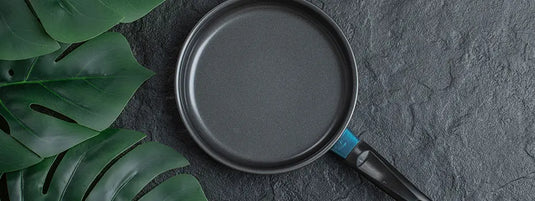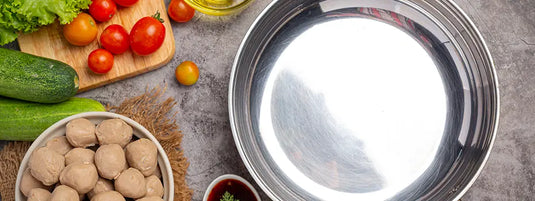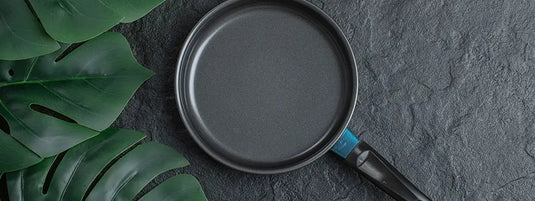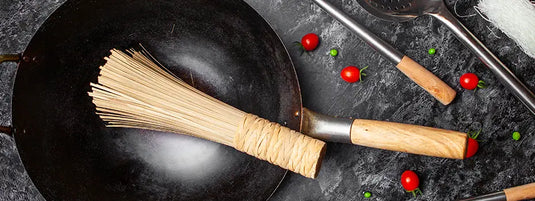Updated: · Kichera Editorial Team · Kichera
Reviewed by: Materials & Culinary Testing at Kichera
Quick Answer
For the healthiest everyday cooking, we prioritise cast iron, carbon steel (sheet iron), triply stainless steel (304/316), and solid ceramic. These materials are durable, non-reactive when used correctly, and safe at the high temperatures common in Indian kitchens.
- Best overall for health + versatility: Triply stainless steel (304/316)
- Natural non-stick with seasoning: Cast iron or carbon steel (sheet iron)
- Low-reactivity for acidic foods (tomato, tamarind): 316 stainless or enameled cast iron
- “Healthy non stick” without PTFE: Well-seasoned cast iron/carbon steel or high-quality solid ceramic (not just ceramic-coated)
Related guides: Safe Pan Temperatures & Oil Smoke Points · How to Season Cast Iron for Natural Non-Stick
What Does “Non-Toxic Cookware” Really Mean?
When we say non-toxic, we mean cookware that does not release unsafe substances at typical cooking temperatures, is stable under heat, and is easy to maintain so coatings don’t flake into food. Traditional PTFE coatings (often called “Teflon”) can degrade if overheated; many “PFOA-free” claims are marketing, because PFOA has largely been phased out already. Our goal here is simple: choose base materials that perform well without relying on fragile chemical coatings.
For comparison-style searches like cast iron vs carbon steel, which cookware is healthier, and is carbon steel safe, we look at health impacts (reactivity/leaching), heat tolerance, and maintenance that keeps pans safe and long-lived.
Cast Iron vs Carbon Steel: Health & Cooking Summary
Cast Iron is thicker and retains heat exceptionally well. It can transfer trace iron (usually beneficial) and becomes naturally non-stick with proper seasoning. Carbon Steel (Sheet Iron) is lighter and more heat-responsive, seasons similarly, and excels at quick tadka/stir-fries. For frequent acidic dishes, we prefer stainless or enamel barriers.
Deep dive posts we’ll interlink within this cluster: 304 vs 316 Triply Stainless for Indian Cooking · Solid Ceramic vs Ceramic-Coated Safety · Safe Pan Temperatures & Oil Smoke Points
Material-by-Material Comparison
| Material | Health & Reactivity | Heat Tolerance | Induction | Maintenance | Best For |
|---|---|---|---|---|---|
| Cast Iron | Inert when seasoned; small iron transfer is normal. Limit long soaks with acidic foods (tomato, tamarind). Learn why. | Very high; ideal for searing/tempering. Check safe temps. | Yes | Seasoning required; dry well to prevent rust. Seasoning guide. | Rotis, dosa, searing, tadka, slow cooking. |
| Carbon Steel (Sheet Iron) | Similar to cast iron; becomes naturally non-stick with seasoning. Slightly more reactive initially until patina builds. | Very high | Usually yes | Season and keep lightly oiled between uses. | Stir-fries, omelettes, crepes, dosa. |
| Triply Stainless (304/316) | Non-reactive; 316 resists acids better. No coatings. 304 vs 316 explained. | High; safe for most stovetop/oven use. | Yes | Low; soak & scrub—no seasoning. | Curries, rice, tomato/tamarind dishes, daily use. |
| Enameled Cast Iron | Non-reactive enamel barrier; safe for acidic foods. | High; avoid thermal shock. | Yes | Low; no seasoning. | Slow braises, dals, gravies. |
| Solid Ceramic | Inert surface; choose reputable brands (lead-safe testing). Coated vs solid. | Moderate-high; avoid extreme thermal shock. | No (unless base added) | Low; use wooden/silicone tools. | Low-oil cooking, gentle saute, reheating. |
| Hard-Anodized Aluminum | Anodized layer is stable; avoid deep scratches. | High | Only with stainless/ferrous base | Low | Even heating at moderate budgets. |
Note: “Ceramic-coated” aluminum is not the same as solid ceramic. Coatings can wear; solid ceramic is a different build.
“Healthy Non-Stick Pan”: What Actually Works
If we want non-stick performance without PTFE/PFAS, the most dependable long-term options are well-seasoned cast iron or carbon steel. Both build a natural polymerised oil layer that behaves like non-stick when we heat the pan first, add a little oil, and avoid cooking very acidic dishes for long durations.
High-quality solid ceramic is another PTFE-free route for low-oil cooking, but it’s less tolerant of thermal shock and abrasive scouring than metal pans.
Safe Temperature & Oil Use
- Preheat pans gradually; avoid smoking oils unless the recipe demands high heat.
- For stainless prevent sticking by: preheat → water drop test (it should bead) → add oil → add food.
- Season cast iron/carbon steel regularly; if food sticks, build seasoning with thin oil coats in the oven/stovetop.
- Use wooden/silicone tools on enamel and ceramic to extend surface life.
Best Picks by Use-Case
- Daily all-rounder: Triply stainless kadhai or saucepan
- Natural non-stick for dosa/omelette: Cast Iron Dosa Tawa 10" · Cast Iron Shallow Fry/Omelette Pan · Carbon Steel (Sheet Iron) Pans
- Grilled textures at home: 2-in-1 Cast Iron Grill & Griddle 10"
- Acidic gravies/dal: 316 triply stainless options or enameled cast iron
Explore all Cast Iron · Explore Carbon Steel (Sheet Iron) · Explore Triply Stainless
So, Which Is Healthier — Cast Iron or Carbon Steel?
Both are safe and healthy when seasoned and used correctly. For frequent tomato/tamarind dishes, we prefer 316 stainless or enameled cast iron to minimise reactivity. For quick, high-heat Indian techniques (tadka, stir-fry) and lighter handling, carbon steel shines. For maximum heat retention and a forgiving seasoning that improves with age, cast iron is exceptional.
- Choose Cast Iron if we want heavy searing, long simmers, and a patina that gets better over time.
- Choose Carbon Steel if we want a lighter pan with faster heat response for daily quick-cook routines.
Care & Maintenance (Long-Term Health + Performance)
- Cast iron/carbon steel: Wash quickly, dry fully, apply a thin oil coat. Re-season if dull or rusty. Seasoning walkthrough.
- Stainless: Avoid salt on a cold, wet base (can cause pitting). For browning, deglaze with water or stock.
- Enamel/ceramic: Avoid metal tools and sudden cold water on a hot pan.
FAQs
Which cookware is good for health?
For most of us, the safest long-term choices are triply stainless, cast iron, carbon steel, enameled cast iron, and solid ceramic. They are durable, stable at high heat, and do not rely on fragile chemical coatings.
Cast iron vs carbon steel: which is better for Indian cooking?
For high-heat, quick techniques, carbon steel’s responsiveness is excellent. For high heat retention and natural non-stick that deepens with use, cast iron wins. Many of us keep both.
Is a non-stick pan healthy?
It depends on the coating and how we use it. If we want a “healthy non stick pan” without PTFE/PFAS, go for seasoned cast iron/carbon steel or high-quality solid ceramic.
Is stainless steel safe for acidic foods?
Yes. 304 is fine for most recipes; 316 offers better resistance for frequent tomato/tamarind cooking.
Cast iron leaches iron—should we worry?
A small transfer of iron is normal and generally safe for healthy adults. If we’ve been advised to limit iron, use stainless or enameled cast iron for acidic dishes.
How do we season carbon steel?
Heat the pan, apply a very thin oil coat, wipe excess, and polymerise at high heat. Repeat a few cycles. Similar to cast iron.
Keep exploring: Cast Iron vs Carbon Steel: Which Is Healthier? (this guide) · 304 vs 316 Triply Stainless for Indian Cooking · Solid Ceramic vs Ceramic-Coated Safety · Safe Pan Temperatures & Oil Smoke Points · How to Season Cast Iron for Natural Non-Stick




